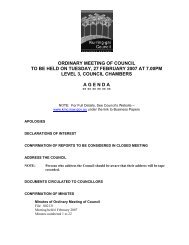Pymble Business Park - Ku-ring-gai Council
Pymble Business Park - Ku-ring-gai Council
Pymble Business Park - Ku-ring-gai Council
You also want an ePaper? Increase the reach of your titles
YUMPU automatically turns print PDFs into web optimized ePapers that Google loves.
13.3 CATEGORY 3 - LANDSCAPE REMNANT<br />
Objectives<br />
1 To maintain smaller key<br />
vegetation communities<br />
remnants as ‘stepping<br />
stones’, providing habitat,<br />
seedbank and pollination<br />
resources (facilitating<br />
gene flow) and supporting<br />
flora and fauna resilience.<br />
2 To maintain and restore<br />
smaller remnants of key<br />
vegetation communities<br />
across a range of<br />
topographies.<br />
3 To protect trees within key<br />
vegetation communities<br />
that provide food, shelter<br />
or nesting resources for<br />
native fauna, or that are<br />
of exceptional aesthetic<br />
value.<br />
Controls<br />
Category 3 - Landscape remnant comprises areas that are more<br />
fragmented than Support for Core Biodiversity Lands (Category 2), which<br />
nevertheless contain key vegetation communities and support core areas<br />
(see Table 3). These areas act as stepping stones or habitat islands to<br />
facilitate the movement of fl ora, fauna and genetic resources through the<br />
urban landscape and across a range of topographical locations. They<br />
also provide important community and aesthetic values.<br />
Category<br />
Category 3<br />
Description<br />
Key vegetation community patches that are ≥ 0.1ha in<br />
size<br />
or<br />
contain vegetation in key vegetation communities in<br />
good, moderate condition<br />
Signifi cant trees 1 within key vegetation communities and<br />
the mapped area in which they are located<br />
1<br />
Signifi cant trees are local native trees identifi ed as signifi cant due to the presence of<br />
habitat (e.g. a hollow), provision of food for wildlife, and / or exceptional form or size.<br />
The inclusion of signifi cant native trees was opportunistic and does not capture every<br />
signifi cant tree within the urban landscape.<br />
Table 3 Areas identified as Greenweb Category 3<br />
1 Avoid locating development on land identified as Category 3 on the<br />
Greenweb map. (Refer to maps in 13R.1 of this Part).<br />
2 Vegetation retention and rehabilitation on sites that include land<br />
identified as Category 3 must be designed to improve connectivity<br />
with existing vegetation and habitat.<br />
3 Planting within sites that include land identified as Category 3 on<br />
the Greenweb map is to consist of not less than 50% locally native<br />
species. Species are to reflect the relevant vegetation communities<br />
within the area. A mix of groundcover shrubs and trees is desirable.<br />
4 Where the site contains high species diversity or is dominated by<br />
weeds within any stratum, a vegetation management plan may be<br />
required.<br />
Note: Noxious and Urban Environmental Weeds are listed in <strong>Council</strong>’s<br />
Weed Management Policy.<br />
Figure 13.3-1: Examples<br />
of Category 3 -Landscape<br />
Remnants<br />
p 180<br />
Draft <strong>Ku</strong>-<strong>ring</strong>-<strong>gai</strong> <strong>Pymble</strong> <strong>Business</strong> <strong>Park</strong> Development Control Plan 2012

















